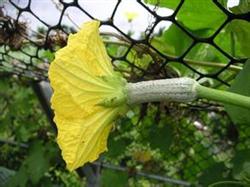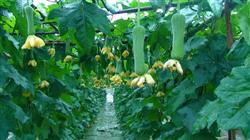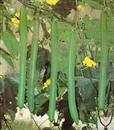Key technical points of towel gourd thinning and beard removal

The reasonable male thinning and whisker removal of towel gourd can reduce the unnecessary consumption of nutrients in soil and plant, make it concentrate on fruit growth and development, and thus increase the yield per unit area. The experiment showed that under the condition of the same cultivation and management, compared with the non-thinning towel gourd, the setting rate per plant, weight and yield per plant increased by 17.9%, 15.9% and 36.8%, respectively. Now the practice of thinning male and removing beard is introduced as follows: first, sparse male towel gourd is a cross-pollinated crop. The female flower has one flower and one fruit, about 15 days from budding to fruit harvest. Male flowers are infinitely growing racemes, each inflorescence can open 20-35 flowers, the total number of male inflorescences per plant is more than the number of female inflorescences, and the pollination ability greatly exceeds the requirement of female flowers. Because the florescence of male inflorescence is longer, about 30-40 days, which is 3-4 times longer than that of female flower, a lot of nutrients are consumed during this period. Therefore, removing the excess male inflorescence as soon as possible can save nutrients and supply the need for female flowers to bear fruit. The method of male thinning: starting from the budding of female flowers, 80% of the male inflorescences on each litter of towel gourd plants are removed and 20% pollinated. Second, remove the beard. Tendrils play a role in climbing and encircling branches in trailing crops. Towel gourd tendrils take a long time from occurrence to death and consume more nutrients, which is not conducive to more melons and good melons. Removing tendrils and using artificial binding instead of climbing function are beneficial to the progress of plant photosynthesis, the manufacture and accumulation of nutrients, the control of diseases and insect pests, and make towel gourd good pollination and high yield. The method of removing beard: in the early stage of towel gourd plant growth, the method of removing beard and binding is adopted to draw the vine to the scaffolding; after the branches are evenly distributed and fixed on the scaffold, the tendrils can be removed at any time with the whole vine.
- Prev

Planting management technology of towel gourd
Sowing and raising seedlings in the first and middle of March. Varieties can choose Hangzhou iron towel gourd, Linhai white towel gourd and other local varieties, the seed consumption per mu is 20O-300 grams. April (1) planting: towel gourd likes fertile and humus-rich soil. Turn deeply and level out to make the bed. The width of the border (connected ditch) is 2.6 Mill 3.3 meters, each row, the hole distance is 50 cm.
- Next

Technical time of autumn planting of towel gourd
After the autumn towel gourd was sown from the middle and late July to the first and middle August, the growth and fruiting period was experiencing high temperature, Rain Water was less, and the autumn wind was rising. It is very easy to cause the seedling vine to grow slowly, the result is less, the disease and insect pests are more, the income is less. Therefore, attention should be paid to the cultivation and management: first, to cultivate strong seedlings and to protect the whole seedlings (1) seed selection. Choose early.
Related
- Where is it suitable to grow horseradish in China? it is expected to see the middle altitude horseradish in Alishan.
- How to prevent tomato virus disease reasonably? (Control methods included)
- Many people like to plant towel gourd on the balcony. What are the main points of this method and management?
- What crops can chili peppers be mixed with?
- Fertilization techniques and matters needing attention in Tomato
- What are the grafting techniques for peach seedlings in spring?
- Harm and control methods of root swelling disease of Chinese cabbage
- What are the pests of sweet potatoes? How to prevent and cure it?
- Symptoms, causes and Control methods of navel Rot in Tomato
- The cause of "Cucumber rotten bibcock" in Farmers' planting Cucumber and its Control Plan

